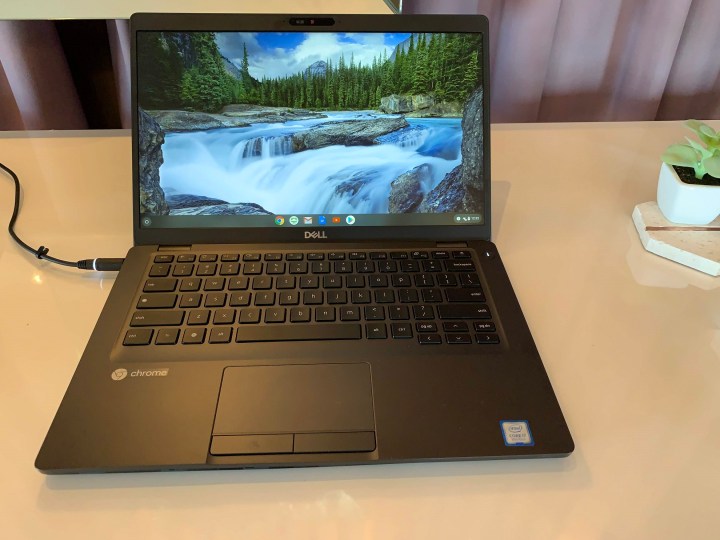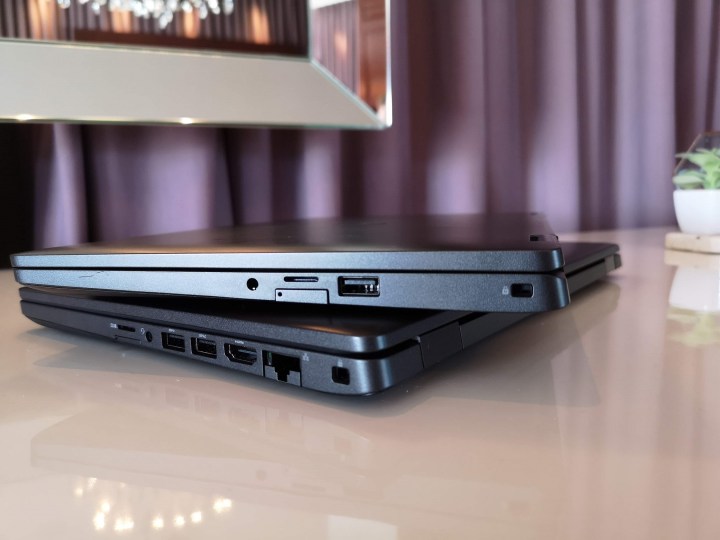Dell is fully embracing Google’s new business-centered Chrome Enterprise initiative by bringing Chrome OS to its Latitude notebook line. Dell’s Latitude 5400 Chrome and its Latitude 5300 2-in-1 Chrome are the first Chromebook Enterprise laptop and 2-in-1 convertible, respectively. Despite their Chromebook designation, these Latitude products bring all the features of Dell’s Latitude platform — which has traditionally been based on Windows OS — to the mix, including upgradeability, serviceability, and easy docking.
We were able to preview Dell’s new Chromebook Enterprise-powered Latitude ahead of their launch at VMWorld, and the user experience is still Chrome OS, so nothing is changing for people who adopt either of these Chromebook Enterprise Latitudes. The main difference with Chromebook Enterprise is the added tools for IT managers to make management and deployment easier.
“We launched the Chrome Enterprise capabilities in 2017 to put critical enterprise features like advanced security protections and fleet management in the hands of businesses deploying Chromebooks,” John Solomon, Google’s vice president of Chrome OS, said in a blog post. “Today, we’re making it even simpler by introducing the new Chromebook Enterprise. Chromebook Enterprise devices come with everything businesses need right out of the box: Trusted hardware and Chrome Enterprise capabilities available and ready to go — no need for a separate license.”
High-end features

Since these are business machines, Dell is focusing on a high-end user experience centered around performance and power. Gone are the ARM processors from consumer Chromebooks, and instead we’re getting eighth-generation Intel Core processors, with up to a quad-core Core i7 silicon option on both Latitude models. In terms of performance, these new Latitudes come with even newer processors than what’s available on Google’s Pixelbook and matches the eighth-generation processors on the Pixel Slate.
In addition to the latest eighth-generation processors, these laptops can support up to 32GB of DDR4 memory, and both models come with fast NVMe solid-state drives with up to 1TB of capacity, rather than the MMC storage on less expensive consumer systems.
The main difference between the Latitude 5400 and the Latitude 5300 2-in-1 is their form factors. The 5400 is decidedly all notebook, and this device comes with a 13-inch FHD display that’s capable of reaching 220 nits of brightness, which is slightly lower than some consumer Ultrabooks given the higher-end CPU configuration. For comparison, the screen on various models of the XPS 13 can reach up to 400 nits of brightness, almost double what you would find on the Latitude 5400 Chromebook Enterprise. Both touchscreen and non-touch configurations are available here, and upgrading to a touch display can be beneficial for enterprises looking to run Android apps. For privacy, the 5400 also features a hardware-based privacy screen to cover the webcam when it’s not in use for Hangouts conferencing or other video calls.

If you need your Chromebook to double as a tablet, the Latitude 5300 2-in-1 features a form factor not unlike that of Dell’s consumer XPS 13 2-in-1, with a 360-degree hinge that allows the 13.3-inch FHD display to convert into tablet orientation. Given the tablet emphasis, touch is standard, and this screen goes a bit brighter — up to 255 nits — to accommodate enterprise workers who may use the device outdoors for field service.
Business-class aesthetics

If you’re familiar with Windows line of Latitude, the understated basic black carbon fiber-finished aesthetics of the Latitude Chromebook Enterprise doesn’t stray much from Dell’s formula. According to Dell, the Latitude Chromebook Enterprise shares 90% of its design, chassis, and components with its Windows cousin, including the carbon fiber-reinforced lid, durable hinge design, and durability testing. Similar to the durability testing on its Windows Latitude variants, Dell stated that the both Latitude Chromebook Enterprise models were tested to 17 MIL-STD specifications. The most immediate benefit to users here is the spill-resistant keyboard, a feature that most consumer notebooks lack.
Despite sharing the same chassis and a large number of components as the Windows variants, enterprise adopters of the Latitude Chromebook Enterprise won’t be able to swap operating systems down the road. This means that if you buy the Latitude with Chrome OS and decide at a future point that you would rather have a Windows notebook, you wouldn’t be able to do that. “Trust us, we thought about that,” Dell’s representative informed us. “But the motherboards are different, and the board used on the Chromebook Enterprise was designed for Chrome OS.”

And even though the bezels on these devices aren’t quite as slim as the XPS 13, they’re reasonable enough to make these laptops relatively compact. The convertible has a footprint of 12 x 8.16 inches and measures just 0.66-inches thick with a weight starting at 3 pounds. The standard laptop version measures 12.7 x 8.5 x 0.77 inches and weighs 3.24 pounds.
Ports aplenty

Like their Windows cousins, The Latitude Chromebook Enterprise devices feature plenty of ports designed to allow enterprises to connect drives, docks, and additional peripherals. Both models feature a single USB-C port that can also be used for charging, single HDMI port, Noble Wedge Lock Slot, and microSD memory card reader. The larger 5400 laptop features three USB 3.1 ports, while the 5300 convertible only comes with two. Given the larger footprint of the laptop, you’ll also find an Ethernet port.
These Latitudes become one of a few Chromebooks to also come with 4G LTE connectivity, making them ideal for business travelers who don’t want to connect to public Wi-Fi hotspots or have to fuss with tethering to their phones. Both models come with an external micro SIM card tray as an option should your business require this feature.
At your desk, the Latitude Chromebook Enterprise notebook and convertible will work with the WD19 Dell Dock, which makes it easier to connect to a larger display, external keyboard and mouse, and other peripherals — like a printer. Typical of the Latitude design, you’ll find plenty of security features, like the H1 Secure microcontroller, verified boot, and sandboxing features. The devices also support Dell Data Guardian Cloud and VMWare Workspace ONE.
Both models will be available starting August 27. The Latitude 5400 Chromebook Enterprise will have a starting price of $699, while the Latitude 5300 2-in-1 Chromebook Enterprise will start at $819.
Updated to reflect MIL-STD testing information from Dell on the Latitude Chromebook Enterprise models.


